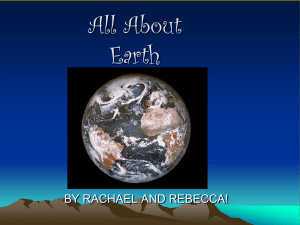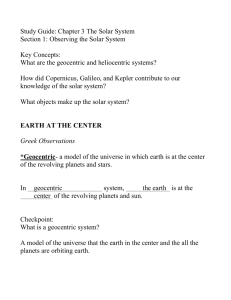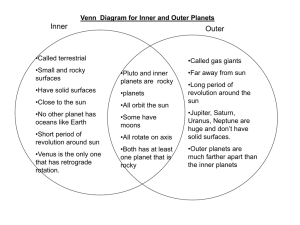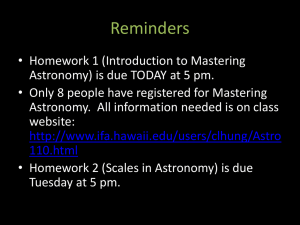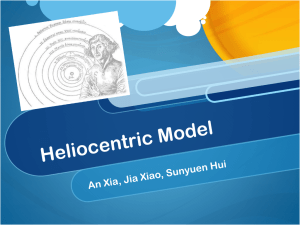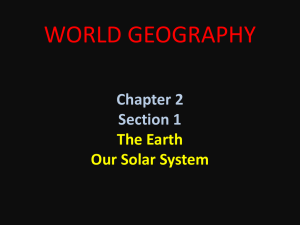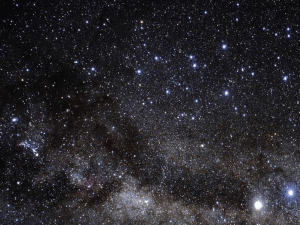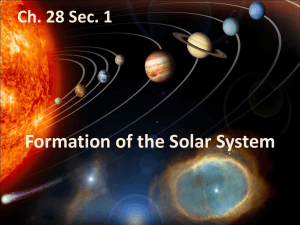Chapter 2: The Solar System
advertisement
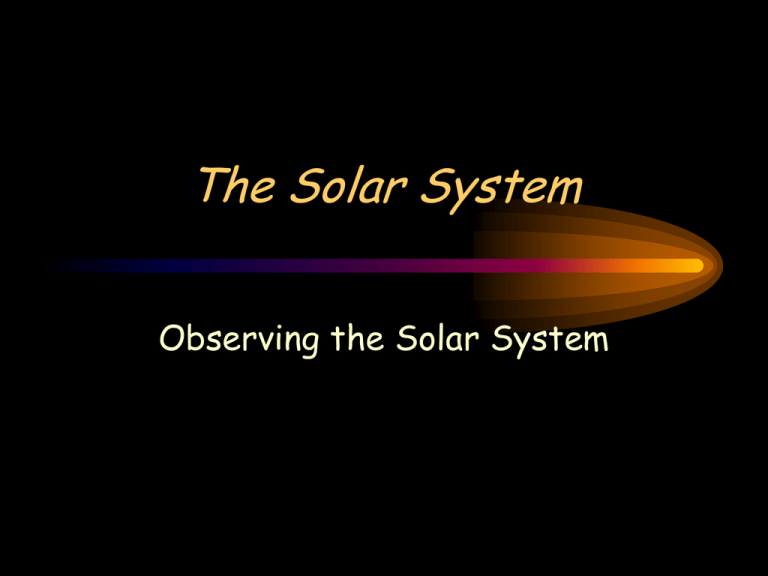
The Solar System Observing the Solar System Guide For Reading • How do the heliocentric and geocentric description of the solar system differ? • What did Kepler discover about the orbits of the planets? • What two factors keep the planets in their orbits? Wandering Stars The Greeks called the five points of light that seemed to move among the stars ______, meaning “______”. • planets • wanderers The ancient Romans later called these planets: • • • • • Mercury Venus Mars Jupiter Saturn Greek Ideas: Earth at the Center Describe the ancient Greek beliefs of the solar system. • The ancient Greeks thought Earth was a stationary object and the sun, moon, and planets were on a rotating celestial sphere Checkpoint: What is a geocentric system? • A geocentric system is one in which Earth is at the center of a system of revolving planets. Figure 2: Interpreting Diagrams Where is Earth located in this illustration? • The Earth is in the middle of the solar system • The sun, moon, and a planet are orbiting Earth on a large circle, while moving on a smaller cirlce How is Ptolemy’s model of the solar system differ from the Greeks before him? • The Greeks before Ptolemy thought the universe was unchanging and the sun, moon, and planets moved together on a celestial sphere (like a carousel). Earth was stationary • Ptolemy introduced the idea of the sun, moon and planets rotating on little circles which rotate on bigger circles Copernicus’s Idea: Sun at the Center Heliocentric • A description of the solar system which all planets revolve around the sun Guide For Reading: How do the heliocentric and geocentric descriptions of the solar system differ? • In a geocentric system, Earth is at the center of the revolving planets. • In a heliocentric system, Earth and the other planets revolve around the sun. Galileo’s Observations Checkpoint: What two discoveries made by Galileo supported the heliocentric description of the solar system? • Jupiter’s four moons revolve around the planet. • Venus goes through phases similar to those of Earth’s moon. Brahe and Kepler Brahe, a ______ ______, made much more accurate observations by carefully observing the positions of the planets for almost _____ years. • Danish astronomer • 20 Guide For Reading: What did Kepler discover about the orbits of the planets • Kepler had discovered that the orbit of each planet is an ellipse. • Ellipse: an elongated circle or oval shape. Ellipse • An elongated circle, or oval shape; the shape of the planets’ orbit Which planet’s orbit did Kepler calculate to discover that a planet’s orbit is not a circle? • Mars Inertia and Gravity Inertia • Inertia: tendency of a moving object to continue in a straight line or a stationary object to remain in place. The more _____ an object has, the more ______ it has. • mass • inertia Gravity • Gravity: The attractive force between two objects; its magnitude depends on their masses and the distance between them. The strength of gravity depends on the ______ of the objects and the ______ between them. • mass • distance Figure 5: Interpreting Diagrams -What would happen if a planet had no inertia? • The planet would be pulled into the sun Figure 5: Interpreting Diagrams -What would happen if a planet had no gravity? • The planet would continue to travel straight off into space Guide For Reading: What two factors keep the planets in their orbits? • Newton concluded that two factors – inertia and gravity – combine to keep the planets in orbit. • Inertia keeps the planets the moving • Gravity from the sun keeps the planets from traveling off in space


